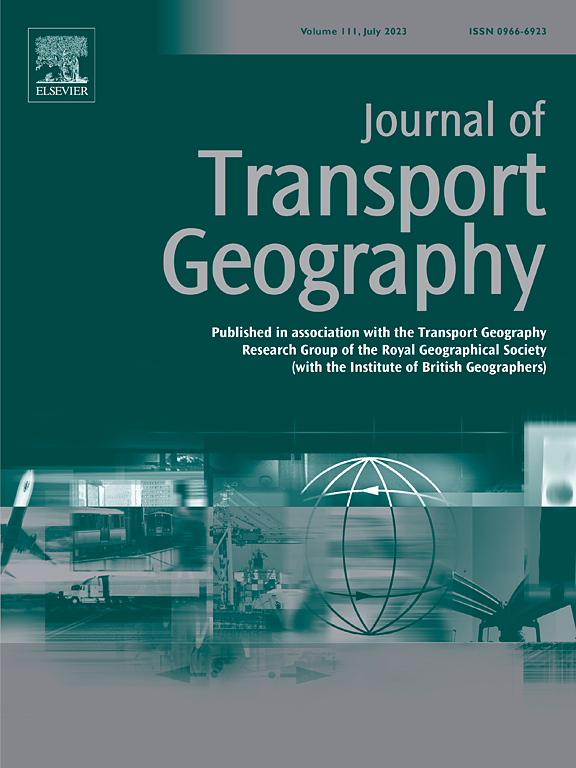集装箱联盟战略、市场集中度与平等性:一种动态时间翘曲聚类方法
IF 6.3
2区 工程技术
Q1 ECONOMICS
引用次数: 0
摘要
全球集装箱运输是国际贸易不可或缺的一部分,对战略联盟和市场集中的作用的细致理解对于跨不同行业的全球物流的持续和安全运作至关重要。本文研究了集装箱航运业联盟部署与市场集中度的时空演化。本文介绍了一种创新的方法——基于联盟部署和市场集中度指标,而不是依赖于预定义的地理边界,使用动态时间扭曲(DTW)对贸易路线进行聚类。该方法揭示了联盟战略与市场动态之间先前未被探索的结构关系,为集装箱航运业的竞争格局和潜在脆弱性提供了更细致入微的理解。我们讨论了联盟部署、市场集中度和不平等如何在全球贸易通道上相互关联或不同的重要问题,以及对国际贸易和市场准入的市场力量或串通行为的潜在威胁的影响。我们的研究结果表明,广泛的联盟部署并不必然导致市场集中度或不平等程度的提高。在主要的东西贸易航线上,高水平的联盟部署与相对较低的市场集中度和不平等相对应,表明多家航空公司积极争夺市场份额的竞争环境。相反,利基市场表现出更高的市场集中度和不平等,共谋行为的可能性增加,特别是在联盟部署很少或没有联盟部署的情况下。我们的研究结果强调,监管机构有必要促进公平竞争,以差异化方式减少反竞争行为,并在全球贸易流动的背景下提高市场准入。最后,我们的研究揭示了小国监管机构与全球领先航运公司之间权力失衡的风险。本文章由计算机程序翻译,如有差异,请以英文原文为准。
Container alliance strategies, market concentration and equality: A dynamic time warping clustering approach
Global container shipping is integral to international trade, and a nuanced understanding of the role of strategic alliances and market concentration is crucial for the continuous and secure functioning of global logistics across different trades. We investigate the spatio-temporal evolution of alliance deployment and market concentration in the container shipping industry. This study introduces an innovative methodological approach - clustering trade routes using Dynamic Time Warping (DTW) based on alliance deployment and market concentration metrics rather than relying on predefined geographic boundaries. The approach uncovers previously unexplored structural relationships between alliance strategies and market dynamics, providing a more nuanced understanding of the container shipping industry's competitive landscape and potential vulnerabilities. We address important questions on how alliance deployment, market concentration, and inequality correlate or differ across global trade lanes and the implications for a potential threat of market power or collusive behavior for international trade and market accessibility. Our findings reveal that extensive alliance deployment does not inherently lead to a heightened market concentration or inequality. On major East-West trade routes, high levels of alliance deployment correspond with relatively low market concentration and inequality, indicating competitive environments where multiple carriers actively compete for market share. Conversely, niche markets exhibit higher market concentration and inequality, with increased potential for collusive behavior, especially where alliance deployment is minimal or absent. Our results underscore the need for regulatory bodies to foster fair competition, mitigate anti-competitive practices under a differentiated approach, and enhance market accessibility in the context of global trade flows. Finally, our research reveals the risk of power imbalances between regulators of small countries and leading global shipping lines.
求助全文
通过发布文献求助,成功后即可免费获取论文全文。
去求助
来源期刊

Journal of Transport Geography
Multiple-
CiteScore
11.50
自引率
11.50%
发文量
197
期刊介绍:
A major resurgence has occurred in transport geography in the wake of political and policy changes, huge transport infrastructure projects and responses to urban traffic congestion. The Journal of Transport Geography provides a central focus for developments in this rapidly expanding sub-discipline.
 求助内容:
求助内容: 应助结果提醒方式:
应助结果提醒方式:


